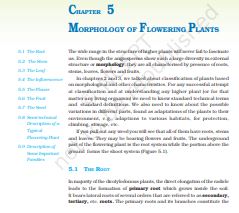‘NCERT Solutions for Class 11 Biology Chapter 5‘ PDF Quick download link is given at the bottom of this article. You can see the PDF demo, size of the PDF, page numbers, and direct download Free PDF of ‘Ncert Class 11 Biology Chapter 5 Exercise Solution’ using the download button.
NCERT Class 11 Biology Textbook Chapter 5 With Answer PDF Free Download

Chapter 5: Morphology of Flowering Plants
The wide range in the structure of higher plants will never fail to fascinate us.
Even though the angiosperms show such a large diversity in external structure or morphology, they are all characterized by the presence of roots, stems, leaves, flowers, and fruits.
In chapters 2 and 3, we talked about the classification of plants based on morphological and other characteristics.
For any successful attempt at classification and at understanding any higher plant (or for that matter any living organism) we need to know standard technical terms
and standard definitions.
We also need to know about the possible variations in different parts found as adaptations of the plants to their environment, e.g., adaptions to various habitats, for protection, climbing, storage, etc.
If you pull out any weed you will see that all of them have roots, stems, and leaves. They may be bearing flowers and fruits. The underground part of the flowering plant is the root system while the portion above the ground forms the shoot system.
5.1 The Root
In the majority of the dicotyledonous plants, the direct elongation of the radicle leads to the formation of the primary root which grows inside the soil.
It bears lateral roots of several orders that are referred to as secondary, tertiary, etc. roots. The primary roots and their branches constitute the tap root system, as seen in the mustard plant (Figure 5.2a).
In monocotyledonous plants, the primary root is short-lived and is replaced by a large number of roots.
These roots originate from the base of the stem and constitute the fibrous root system, as seen in the wheat plant (Figure 5.2b).
In some plants, like grass, Monstera, and the banyan tree, roots arise from parts of the plant other than the radicle and are called adventitious roots.
The main functions of the root system are the absorption of water and minerals from the soil, providing a proper anchorage to the plant parts, storing reserve food material, and synthesis of plant growth regulators.
5.1.1 Regions of the Root
The root is covered at the apex by a thimble-like structure called the root cap (Figure 5.3). It
protects the tender apex of the root as it makes its way through the soil.
A few millimeters above the root cap is the region of meristematic activity. The cells of this region are very small, thin-walled, and with dense protoplasm.
They divide repeatedly. The cells proximal to this region undergo rapid elongation and enlargement and are responsible for the growth of the root in length.
This region is called the region of elongation. The cells of the elongation zone gradually differentiate and mature.
Hence, this zone, proximal to the region of elongation, is called the region of maturation.
From this region some of the epidermal cells form very fine and delicate, thread-like structures called root hairs. These root hairs absorb water and minerals from the soil.
| Author | NCERT |
| Language | English |
| No. of Pages | 21 |
| PDF Size | 2.5 MB |
| Category | Biology |
| Source/Credits | ncert.nic.in |
NCERT Solutions Class 11 Biology Chapter 5 Morphology of Flowering Plants
1. What is meant by modification of root? What type of modification of root is found in the:
(a) Banyan tree (b) Turnip (c) Mangrove trees
Solution:
In order to carry out some secondary functions or a specific adaptation, roots modify their structures – which can be its size, shape, or even normal functioning. This is referred to as modification of roots.
a) In banyan trees, roots develop from the branches and they go deep down the earth to render mechanical assistance for the tree. This kind of modification is known as prop root.
b) In turnip, roots are modified to store food, and this type of modification is called a fleshy taproot.
c) In mangrove trees, the roots are modified into a pneumatic structure to provide oxygen to the tree. This type of modification is called respiratory roots or pneumatophores.
2. Justify the following statements on the basis of external features:
(i) Underground parts of a plant are not always roots.
(ii) The flower is a modified shoot.
Solution:
i) In a few plants like ginger, stems remain underground for vegetative reproduction and storage of food. Similarly stems in potatoes remain underground which are modified stems.
Potato tuber indicates the presence of nodes (buds and scale left here) and internodes. The presence of an apical bud at the tip of the potato tuber affirms it to be a stem. Hence, these examples show that underground parts are not always roots.
ii) Apical meristems give rise to floral meristems, and the axis of the stem gets condensed while internodes lie nearer to each other. Because of this, floral appendages rise in place of stems, this justifies that the flower is a modified shoot.
Morphology of Flowering Plants NCERT Textbook With Solutions PDF Free Download
